All weather rugged modular enclosure
or
Outdoor Wi-Lan box
|
By Dan Santillan |

I found a metal box enclosure that is well suited for my "All weather" access point, i bought it for 50USD in one of the local electrical store here, the box is 2mm thick and has a powder coated paint, it is heat and fire resistant and fully water proof, as you can see in the pic, it has a lock too! there’s a 3mm base plate that goes with it and underneath there is an access panel plate that you can remove and drill a hole for whatever purpose.
This box will house my proprietary Wi-Lan HP45-24 radio unit and set as a client, a 2.4ghz 500mw HyperLink Amplifier connected to a Linksys WRT54G with a third party firmware and set as an access point, the Wi-Lan HP45-24 radio will be the main link back to my base radio.
|

Front side Wi-Lan HP45-24 I bought this unit last summer of 1998 and the maximum throughput is 4.5mbps only, the original firmware of this unit was version 4.xx and limited to 5 channels only, recently; i upgraded the firmware version to 6.xx and now it has 8 channels, BTW the frequency of each channel is not a Wi-Fi standard, bear in mind that this unit is a proprietary, it is still within the 2.4ghz ISM band but not the way wi-fi band was allocated.
|
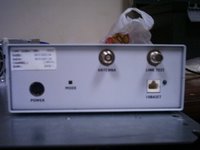
The back side of the Wi-Lan has a 10base-T LAN connection, an Antenna connector, and a "Link Test" connection probe, which you can use to test the signal level by using an spectrum analyzer or a simple "Digital Volt-meter", this unit requires a dual volt, a +12v and a +5 volt, the original PSU that comes with this unit has a low amp rating and for indoor use only, instead of using it, i opted to use a regular ATX power supply, i removed the unnecessary wires from the ATX PSU, all i need from the PSU is the regular power lead that is used to power up HDD/FDD/CD, i removed the power lead for the main board, and i shorted the PWR-ON lead to the ground lead for constant ON., my friend suggested that i should install a switch instead of shorting the leads and since this box will be located in the roof i don’t see any purpose installing a switch.
The whole idea of this enclosure is to be as "modular" as possible, i.e. if the PSU blows-up i can simply remove the PSU and replace it, OR if i need to relocate the whole box, i can simply unscrew all the antenna and take it away with me.
|
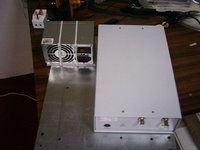
I mounted the Wi-Lan unit and the PSU unit to the base plate of the box.
|
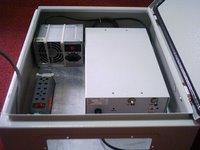
My initial approach for the main power is to house it inside the box, i come-up with this after mounting the Power Extension cord, the Wi-Lan unit and the PSU, later on i decided to drop the power cord extension as this may cause an electrical hazard plus is takes some space, and since this unit will be "modular" i come-up with an idea of mounting a power socket at the bottom of the box, i have a broken PSU lying around and i took the mains power socket and flush mount it at the access panel plate and cover the sides with epoxy.
|
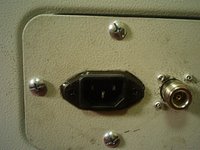
My friend is very concern about my idea and he told me that the socket is dangerous as it is exposed and not water proof, i told him that the socket is secured enough because the matching lead that will goes into it is secured and water tight plus i will put some kind of rubber shielding around it. If you are unsure about the way it looks, have a look at your PC’s power lead, as you notice, the main power lead contact point is buried at least 4 mm deeper, and there is no way a water can get into it especially the whole box will be installed in a upright position.
|
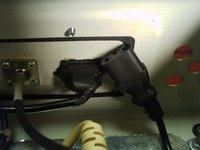
I cut a PC power lead and solder it directly to the main socket, i use a lot of shrink tubing and a "Vulcanized Tape" to secure the electrical leads from touching the base plate although it doesn’t touch even without the tapes but better to be sure of safety. The other end of the power lead will be connected to the ATX PSU.
|

I bought few N-Type flush mount connector, and mount it at the panel access plate, to make a pigtail of this kind of connector, I stripped a RG58 50 ohms coax cable, I stripped the shield of centre wire to 1mm enough to insert it at the centre pin of the N-Type connector, then I stripped 1mm of the outer shield enough for the inside shield to touch the centre in of the N-type.
|

I folded back the braid shield and insert the tube half way just enough for me to solder the centre pin then i pushed back the tube towards the base of the N-Type.
|
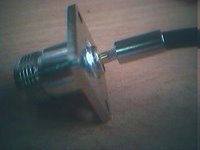
Then I solder the edge of the tube to the base, make sure you solder the whole edge around it and also make sure you strip the coax cable as short as possible and connect it to the N-Type connector as close as possible, after soldering the tube I crimped the tube.
|
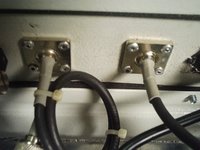
After soldering the coax I mounted it at the panel access plate next to power main socket.
|
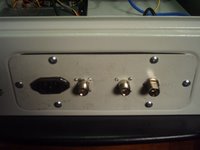
From left to right – Main socket, Antenna connector attached to amplifier, another antenna connector with RP-TNC on the other end (reserved purpose) and the last one is a N-Type lightning arrestor connected to Wi-Lan radio (yeah i need a protection for that unit, Wi-Lan is an expensive radio and it is not a common wireless unit, they are mainly used for backhaul)
|
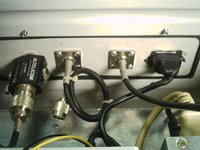
Hyperlink 500mw Amplifier / Lightning Arrestor / Inside the box after making all connections
|

I don’t intend to use the Linksys Power Adapter, instead i made a cable for it and i will attach it to the ATX PSU, since the Linksys only require +12volt and 1 amp of power, the PSU is more than enough to power my Wi-Lan radio and the Linksys radio, however my amplifier requires more voltage and i cannot use the PSU supply.
|
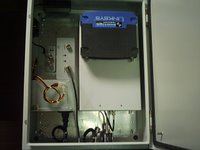
Instead i cut the power lead of my amplifier and i solder a power socket to be connected at the PSU aux power (the one where the monitor power lead is connected). From Left to Right – amplifier power lead – Wi-Lan power lead – Linksys power lead
|

This is what it looks like after putting everything in place as you can see the ATX PSU fan is facing the hole I drilled underneath to blow the hot air out, it is also an option to install a PVC tubing at the outside hole to prevent any water to get in and a filter pad to prevent dust, bugs etc. I might as well add a 80mm fan at the hole or at the pvc tube to take more hot air out.
|

Behold!!!!….
The monstrosity I created…!
|
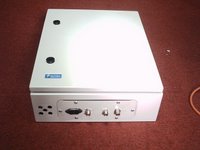
What i have achieved is an enclosure that is weather proof and fully modular in case i need to replace any component particularly the PSU, it also allows me to move the whole box anywhere i need to put it, plus it is a lot more easy to disconnect all antenna connections.
I hope you enjoy my DIY "All weather-rugged-modular enclosure"
|
This article has been reposted with the permission of the author.
The original article can be found
here

November 15th, 2005 at 18:10
It is recommended to treat all connections with dielectric grease before attaching the wires. The dielectric grease is a non-conducting grease that will not cause short circuit across the connector leads, and will fill the air gaps to prevent them from getting water in case of rain. The grease repeals the water and will extend the life of the contacts. Fill the connector with enough grease – the metal leads will displace the grease where required and will make a good metal to metal contact.
The easiest dielectric grease to find is the the one used for car tune-ups (spark plugs, etc.). Check your auto-parts. If you are going to use a lot, you can check the company that makes the grease for the car making companies:
http://www.nyelubricants.com/
You can place a small size order from ther small volume distributor:
TAI Lubricants, Inc.
P.O. Box 1579
Hockessin, DE 19707
Tel: 302-326-0200
Fax: 302-326-0400
Toll Free 1-877-99NYOIL (1-877-996-9645
I ordered from the NyoGel 760G for shielding some ethernet data drops from the corroding sanitizating products at my work. They may recommend another one for you application.
Finally, consider placing some Liquid Tape(r) outside of the connection for further shielding. You can buy it at Home Depot.
April 13th, 2006 at 12:20
one thing if your removing it from the 2.4 ghz allocation then your no longer on the freq supplied so your over the fcc limit and crossing over on the 2cm ham band and 40 cm band which is highly illegal and will get you about a 500,000 buck fibne per hour and YES they will find you!
better check your sig freq in and outs and ask a local ham if its in there band spectrum.! good idea but highly advise you to do this to avoid a massive fine i myself am a ham radio operator licensed by the FCC!.
June 14th, 2006 at 21:20
Just because Rob Johnson is a ham radio operator that does not mean that he is an expert on all FCC matters. First of all, the 2.4GHz is used by many, including but not limited to the ham radio. Secondly, the ISM use and ham use overlap the band, so there can be some “crossing over” but that does not mean it is illegal. Third, he already stated that it is within the ISM band, and thus legal, and Mr. Johnson can’t read. Forth, there is no such 500,000 buck fine per hour, never heard of such a high and ridiculous fine. It is simply not true and you (Mr. Johnson) is just doing this to scare people.
There is only one thing that can make it illegal is that the modification of such equipment such that the EIRP has exceeded the ISM standard power limit. Ironically that is never mentioned by Mr. Johnson.
Mr. Johnson, you are giving a very bad name to the ham radio community and you should be ashamed. By pretending to be an FCC law enforcement and yet you don’t even know the stuff. May be you should post your ham radio callsign to be on the record here.
BTW, ham radio operators do not have exclusive right on the 2.4GHz band even within the their own allocation because it is a secondary allocation and not a primary allocation and any interference or inconvenience because of legal sharing has to be tolerated by the ham radio operators.
Yes, it is this kind of sentiment (pushy) that gives ham radio (amateur radio) a bad name. You are ruining it for everybody.
June 15th, 2006 at 1:30
It seems that Mr. Johnson cannot read at all, does Saudi Arabia means anything to you?? correct me if i am wrong but FCC legalities is confined within the U.S. only and NOT in Saudi Arabia, so who cares if the guy breaks any FCC regulations, he is in saudi arabia anyway!
June 19th, 2006 at 13:02
Two other hams and myself have been experimenting using Linksys WRT54GS’s on channel 4. Just from hearing gossip over the fence from my neighbor he said that himself and the neighbor accross the street can not use their Wireless Lan laptops most of the time. I only run the default power output from the router but am using a gain grill type antenna. I know I am the reason for their interference and am wondering what I can do about it? Don’t want to give them any advice since that would prove that I am the culprit. Thanks
September 11th, 2006 at 11:07
AL,
The easiest answer (and possibly one you already thought of) is to switch your network’s channel. If you’re using channel 4 and causing interference, that means your neighbors are probably using a channel anywhere between 1 and 8.
Push it up to channel 11, and you’ll hopefully be using a totally different band than them, so your interference will drop dramatically. Check this out for more info:
http://www.wi-fiplanet.com/tutorials/article.php/972261
February 4th, 2008 at 3:49
Love it. I watched this done for many WiFi Network projects where neighborhood’s share internet this way but there boxs are tuber ware and no where this clean. Maby if I can get my area to donate to a project like share internet each pay a dollar a month type access I may have to find you or find someone like you willing to make some side cash how far do you think it can cover? Thank you for any reply keep up the good DIY work I love reading we need start getting videos of these great projects.
Greg M.
CEO – SlumHosting
May 13th, 2008 at 20:40
I wanted to do a project like this but had some unsolvable issues since boxes like this are not designed to hold equipment like this.
What happens to the heat generated by the equipment? What about the cold? Humid weather?
For instance:
WRT54G Environmental Parameters
Min Operating Temperature 32 °F
Max Operating Temperature 104 °F
Humidity Range Operating 10 – 85%
All of these seem easily exceeded in summer or winter in many places – certainly everywhere I’ve lived.
June 11th, 2008 at 22:26
Leave it to the Hams to come online and start bitching. The spectrum allocated to ham operators is ridiculously large and under-utilized. I suggest you evolve to a more efficient use of the protected spectrum you have been granted before fighting over the ISM space you have to share!!!
July 11th, 2008 at 20:37
Very nicely built project! Yes, I am a Ham. Extra class. And I’m not shy to post my
call sign.
First about Mr Johnson… What is he talking about? 2cm and 40cm
Ham band crossover? Helooooo… 2.4GHz is 8cm wavelength. 4cm half wavelength.
Where did this so called “ham” above get 2 and 40 cm from? Talk about making us look
bad. 2cm is ~1.4GHz and the linksys gear would HATE running that far out
of its designed band. And 40cm is 750MHz.
And a “500,000 buck fibne per hour” (sic)
not likely. If this were used in the US and if the FCC gets a complaint and if the FCC
finds where you are it would be more like a warning, and a slap on the wrist with a letter that
says “…don’t do that again.” Maybe a token fine to show their appreciation. (Note: This is
not a recommencation to just go out and do this! Its just a comment on the state of
the FCC right now and how busy they are with “real” work.)
Besides most Hams don’t refer to any bands above 23cm by their wavelength. They refer by
the frequency allocations.
I would be concerned by the AC cord powering the enclosure. Water could— maybe —-
possibly — (ok unlikely) get inside it. The dielectric grease is
good suggestion. A weatherproof connector is a better idea.
Seriously, that is a nice looking enclosure. And it is a good use of the ATX
power supply. Its clean. Cables are well-dressed. And it is easily serviced. Nicely done!
I don’t know why I bother to post on three year old pages, but… oh well. Must be
a slow friday night.
One last note: Since the unit is using only one antenna I thought I’d mention that
the Linksys may not do antenna diversity well. It would probably work
better with firmware like DD-WRT where you can select the antenna that is in use.
(Unless the current version of firmware from Linksys supports selecting the preferred
antenna.)
Al, you’re probably not the reason your neighbor cannot use their WiFi. Its spread-spectrum so
the odds of being on the same frequency at the same time are not that significant. It is more
likely there is something wrong with their setup. Although you would sometimes
interfere with them, some percentage of traffic would get through. Probably at a somewhat
reduce rate of speed. I’ve had systems with multiple WiFi APs on the same channel. (6 once)
Its not ideal, but it works. They should look for something more obvious like a 2.4GHz phone
running on the same frequency and causing interference. Microwave oven also is a pain in the
back end… they are around channel 8 and trounce all over the signal from WiFi.
Dan